Oswald Mosley & the British Union of Fascists

Sir Oswald Mosley (16 November 1896 – 3 December 1980), the most notorious British Fascist
Though Mosley’s Fascist Party doesn’t really play an important part in my new Resistance book, The Highland Raven, I think this is a part of pre-war British history that isn’t as well-known. Moreover, this man and his wife, hung on to their preposterous belief systems all their lives.
Introduction
Since he launched his British Union of Fascists, Sir Oswald Mosley has been considered Britain’s most well-known fascist. He was staunchly anti-Semitic and friends with the likes of Adolf Hitler and Benito Mussolini. What's more, he remained a fascist until he died near Paris on 3 December 1980.
Childhood
Sir Oswald Ernald Mosley was the eldest son of a baronet, born in a London aristocratic family in Mayfair, London, on 16 November 1896. He enjoyed a privileged upbringing, educated at Winchester College and then at the Royal Military College at Sandhurst. He was an excellent fencer and boxer.
Considered odd by many of his peers at school, Mosley had few friends and was expelled from Sandhurst after just six months, following a fight with another student. Reportedly, this was related to the defeat on the polo field by the rival military academy Aldershot.
Mosley's Political Rise to Power
Oswald Mosley was the House of Commons’ youngest member when he took his seat in 1918 at the age of just 22 as the Conservative MP for Harrow. He had served in the World War I in the Royal Flying Corps and the 16th Lancers, before working in the Ministry of Munitions and the Foreign Office.
Not long after being elected, Mosley became disillusioned with the Conservative party. In 1922 and 1923 he was re-elected in Harrow as an Independent, but then joined the Labour party in 1924, thus seeing both sides of the House of Commons.
In the early 1930s, Mosley's star was rising under the Labour Prime Minister Ramsay MacDonald. As Chancellor of the Duchy of Lancaster (a minister without a portfolio), his job was to deal with the unemployment crisis caused by the 1929 Wall Street Crash. Almost three million people eventually became unemployed in the UK.
Averse to adopting what he considered 'an orthodox deflationary response' to the economic crisis, Mosley instead proposed public work schemes and the nationalization of primary industries. However, the Cabinet found this “very dynamic and interventionist approach” rather too radical and rejected it. Mosley, furious and disappointed, saw no other route than to resign from the cabinet, which he did in May 1930.
The New Party
Soon after, he established the New Party, which became the predecessor of the British Union of Fascists. Combining an odd mix of radical left and conservative right members, it flopped. New Party meetings were often disrupted by Communists who ferreted out the party's “incipient fascism”, but also by Labour party members who felt betrayed by Mosley. The violence and thuggery of the so called ‘Biff Boys’, Mosley's bodyguards, set the tone for the New Party. In the BUF, these bodyguards would become known as Mosley’s Blackshirts.
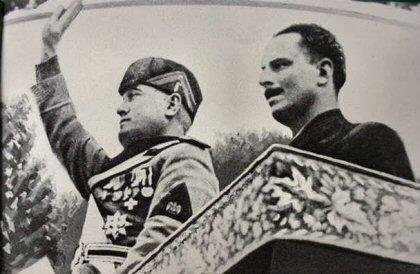
Benito Mussolini and Oswald Mosley
When the New Party didn't take off, Mosley visited Italy to meet with Benito Mussolini, the Italian fascist dictator, Il Duce. Impressed by the Republican Fascist party and its leader, Mosley founded the British Union of Fascists on his return to England. It was modeled on Mussolini’s party system.
The British Union of Fascists
The BUF was officially established by Mosley in October 1932. It disbanded in May 1940, at the end of the Phoney War, so was active throughout most of the 1930s.
The BUF immediately established itself as a radical, dynamic counter-force to the conventional political parties governing Britain. To display that strive was necessary to make change possible, the BUF members chose a paramilitary style, such as Blackshirt uniforms inspired by Mussolini’s forces. Mosley's men, however, donned a fencing-type tunic as uniform.
They introduced the fascist salute, the right arm extended, like other fascist groups on the Continent. The ‘fasces’ became the BUF' symbol (a bundle of wooden rods and an axe held together by leather thongs), very like Mussolini's symbol. Later he replaced it with the lightning flash in a circle, to express action and unity.
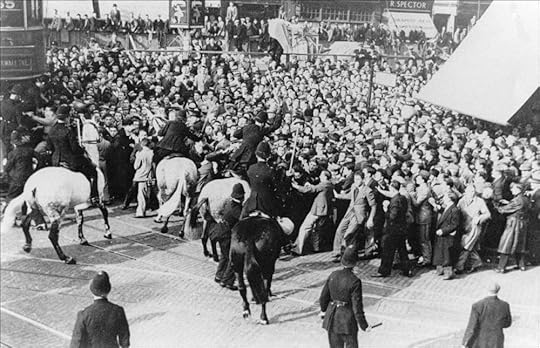
A BUF March
The BUF became renowned for its marches, meetings, and public rallies. Towards 1934, these events attracted substantial crowds, for example in the Olympia in London, Albert Hall, Hyde Park, and Belle Vue Gardens in Manchester.
The meetings were often met with resistance from anti-fascist movements. Especially, the rally at Olympia in London in 1934 led to a clash, with the Blackshirts resorting to horrible and uncalled-for violence.
After Olympia, the attitude of the public changed, based on the press coverage of the outrageous behavior of Mosley's bodyguards. But this didn't stop the BUF. On the contrary, it had found its footing and adopted a militant anti-Semitic attitude of intimidation, harassment, and violence against British Jews, particularly in the East End. That part of London housed around 100,000 Jews at the time.
In October 1936, after Mosley had announced a march through the East End, some 200,000 people gathered to try to prevent it by forming a human barricade at Gardiner’s corner and erecting barricades at Cable Street. The clash that resulted between anti-fascists and the police forced Mosley to abandon the march.
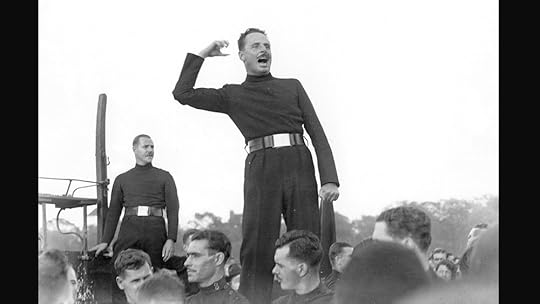
Mosley at the Olympia Rally
Anti-Semitism was a key aspect of the BUF’s ideology, in line with Hitler's ideology but different from Mussolini's, who never was an anti-Semitist. There was a difference between the BUF's anti-Semitism and that of the Nazis, though, as Mosley adhered more to a form of conspiratorial cultural anti-Semitism instead of the racial anti-Semitism prevalent in Germany.
As far as the BUF's economic and political ideas were concerned, they were mainly a reaction to the Great Depression. Mosley believed in a ‘corporate state’, a parliament based on an occupational franchise rather than an electoral franchise. Each industry was to be organised in a corporation, providing a partnership between employers and employees. Over and above that, Mosley’s fascist government would rein, answerable only to the king. It was to be a form of ‘modern dictatorship’ with some input from the people.
The BUF's Popularity
In the early years, the BUF grew fast and had a substantial support, also thanks to Lord Rothermere, the owner of the Daily Mail, who sponsored the party lavishly. In January 1934, he published the infamous article “Hurrah for the Blackshirts!” With Rothermere’s help, BUF grew to 50,000 members in 1934.
After the violent Olympia Rally in the autumn of 1934, Rothermere withheld with support and by the end of 1935, the BUF had only some 5,000 members. After the declaration of war on Germany in September 1939, the party grew again to around 22,500 members, largely because the BUF supported the anti-war appeasement.
They were never large enough electorally to have a seat in Parliament, though they had some local successes.
The BUF's connection to the fascist regimes in Germany and ItalyMosley's closest ally was Mussolini. On his visit to Italy in April 1933, he was given the honour of a 100,000-strong Blackshirt parade. After 1934, the BUF also received a substantial subsidy from Mussolini's government.
Mosley anti-Semitic speeches were praised by Hitler. This is a 1935 telegram Mosley sent to Hitler as a response to his,
“Please receive my greatest thanks for your kind telegram in relation to my speech in Leicester, which was received while I was away from London. I esteem greatly your advice in the midst of our hard struggle. The forces of Jewish corruption must be overcome in all great countries before the future of Europe can be made secure in justice and peace. Our struggle to this end is hard, but our victory is certain.”
Like Hitler, Mosley had found his scapegoat for all that was wrong in society in the form of the Jewish population. Anti-Semitism became the essence of Mosley’s manifesto.
By 1937, Mussolini had become less in favour of Mosley's leadership and the subsidy was withdrawn. It meant the need for major cuts at the BUF’s London headquarters. The Northern Command HQ was closed, and several leading officials were dismissed. It also meant Mosley became even more reliant on Nazi-Germany.
After the party was rebranded to the British Union of Fascists and National Socialists in 1936, funds from Berlin trickled in, but they were substantially less than Mussolini's subsidy. On theory is that Hitler saw Mosley as more of a thinker than a doer.
Oswald Mosley as leader
Mosley created his image carefully. He took a stance as the quintessential new fascist man, charismatic, flamboyant, virile, athletic, supremely masculine, and a skilled orator.
This image contrasted with the so-called feminised and decadent political classes in power in Britain in the 1930s. The leadership cult built around Mosley as the man-in-charge was an important part of the party culture.
The British that joined the British Union of Fascists
A motley social group was attracted by the BUF. In London's East End, these were mainly groups of working-class men that weren't members of unions, but there were also many middle-class supporters. The paramilitary display appealed in particular to young men. Some 75% was male, 25% female.
Initially, when supported by the Daily Mail, middle-class people considered Mosley as a leader who would offer them a dynamic form of conservatism, an alternative for the Conservative party. But the rise of anti-Semitist propaganda drew a different audience to the BUF, certainly in the East End. Towards the end if the 1930s, the support was more middle class again, following the appeasement, anti-war policy.
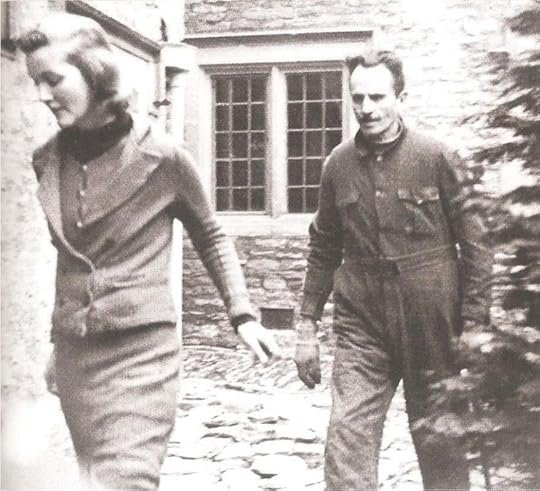
Mosley and Diana during their prison years
The Disbandment of the BUFAfter the declaration of War in 1939, the British government directed its arrows more towards fascist activity inside the country, especially the connections with Berlin. With the Nazi blitzkrieg erupting in the spring of 1940, the British government feared that Mosley’s party would become a ‘fifth column’ in case of a German invasion. Like Quisling in Norway, Churchill feared that, in the event of a surrender to Germany, Mosley would become “Hitler’s puppet” in Britain.
In May 1940, Mosley and some leading BUF members, including Mosley’s wife, Diana, were arrested and interned under Defence Regulation 18b. This law suspended the right of habeas corpus and permitted arrest without charge, and detention without trial. Some 750 BUF members were interned under this law.
Mosley and Diana were first held at Holloway Prison and later placed under house arrest. They were released in 1943 because of Oswald’s ill-health. In July 1940, all BUF political activity ceased when the organization itself was shut down.
After the WarThe BUF members interned during the Second World War continued to “keep the flame alive” and support Mosley, but among the British population, Mosley was widely seen as a traitor. He tried to get back into politics after the war, after establishing a new far-right party called the Union Movement in 1948, still focusing on anti-Semitism, but he never had the success he'd known before the war.
Together with his wife, he set up Euphorion Books to publish right-wing authors, including his own books. Euphorion Books also published a far-right magazine called The European from 1953 to 1959, which Diana edited.
Mosley never expressed regret for his pre-war ideologies. On the contrary, he denied the Holocaust, his lust for power was unchanged, and he continued to spread his fascist ideas. Many historians consider Oswald Mosley a central player in the emergence of Holocaust denial in post-war Europe.
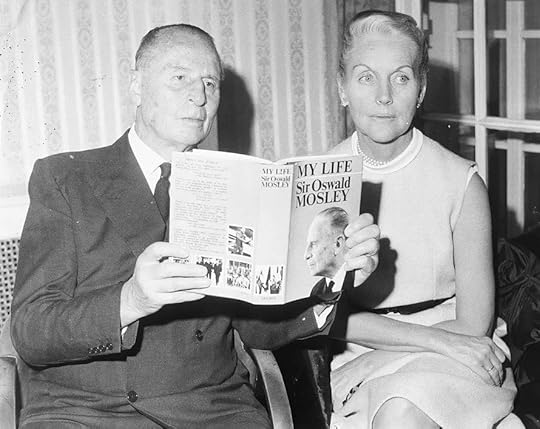
Mosley and his second wife, Diana
His Union Movement newspaper derided ‘concentration camp fairy tales’ while he also denied the Nazis had a conscious mechanical extermination programme. Mosley also adhered to the theory that Hitler was totally oblivious to the Final Solution.
After some years in Ireland, Mosley returned to the UK to run as an MP in the 1959 General Election for Kensington North and in 1966 for Shoreditch and Finsbury. Both times he was defeated. He then retired to France with his wife, where he wrote his autobiography, My Life, which was published in 1968. He denied he'd ever been an anti-Semite.
In his final years he suffered from ill-health and Parkinson’s disease. He died at his home in Orsay, near Paris, on 3 December 1980.
The wives

Mosley with his first wife, Lady Cynthia Curzon
Lady Cynthia Curzon
In 1920 Mosley married Lady Cynthia Curzon, a Labour politician and the daughter of the esteemed Conservative leader Lord Curzon of Kedleston. The wedding was a huge social event, at which even King George V and Queen Mary were present. But Lord Curzon (and many others) was convinced Mosley had only married his daughter for a shameless rise in the Conservative party's ranks. The marriage was blemished by Mosley’s endless affairs, including with both of his wife’s sisters and with their stepmother.
By the early 1930s, Lady Cynthia Mosley deviated from her husband's political ideas, being concerned about his move towards fascism.
Mosley and Cynthia had three children. Vivien (b 1921), Nicholas (b 1923), and Michael (b 1932). Lady Mosley died of peritonitis in 1933, when her youngest son was only one year old. It was also the year Adolf Hitler came to power in Germany.
Diana Freeman-Mitford
Oswald Mosley married his second wife, Diana Freeman-Mitford, in 1936, at the home of Nazi propaganda minister Joseph Goebbels. Diana had been Mosley’s mistress for a few years when he was still married to Cynthia. She left her husband, Bryan Guinness, heir to the brewing fortune, for Mosley, but he had refused to divorce Cynthia.
Diana was the third eldest of the six Mitford sisters, a family of famous aristocratic socialites who held controversial political views. some of them were friends with Adolf Hitler, others embraced Communism.
Hitler was one of the six guests at Oswald and Diana's marriage. He attended as the guest of honour. It was a secret wedding taking place at Goebbels’ house in Berlin. Hitler gave the pair a photo of himself in an eagle-topped frame.
Diana was as much an active fascist as her husband. She regularly drank tea with Hitler and had a strong affinity with him. They made plans for a pro-Nazi radio station in Britain, but this never materialised.
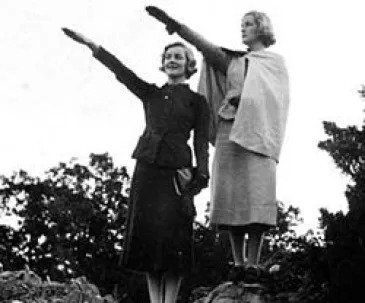
Diana and Unity, The fascist Mitford sisters
Diana and Mosley spent the first years of WW2 in prison. MI5 documents from 1940 that were released in 2002 revealed that the security services considered Diana the greater threat than her husband.
“Diana Mosley, wife of Sir Oswald Mosley, is reported on the best authority, that of her family and intimate circle, to be a public danger at the present time. Is said to be far cleverer and more dangerous than her husband and will stick at nothing to achieve her ambitions. She is wildly ambitious.”
In her obituary in the Guardian following her death in 2003, Diana was described as “the most hated woman in England”.
Mosley and Diana had two children, Oswald Alexander, in 1938, and Max, later the famous Formula One racing tycoon, in 1940.
Max Mosley was known for revolutionizing the sport and dubbed the ‘Godfather’ of Formula One.



